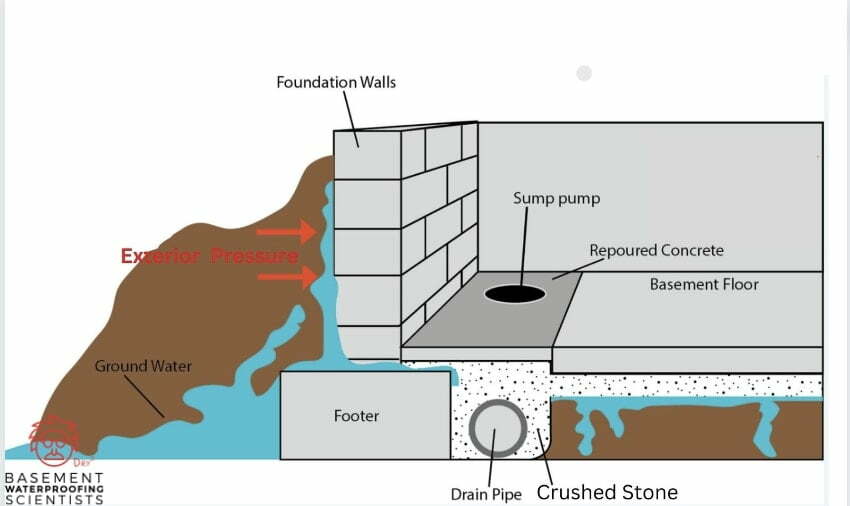
Mold in the Basement and the Importance of Basement Waterproofing
Basement mold is a frequent nightmare for most homeowners, silently threatening not just the structure of the house but also the health of its occupants. Mold spores may seem insignificant, but their effect is substantial. Below, learn about what causes mold growth in basements, why it’s such a severe problem, and how to address and prevent it through proper measures, including basement waterproofing.
Understanding the Threat of Basement Mold
Mold spores, the microscopic seeds of mold, thrive on organic materials like wood surfaces, insulation, and drywall. The basement, often rife with humidity and excess moisture, provides an ideal breeding ground. Moisture issues are usually due to leaks, condensation, and high humidity levels in the basement. Here’s why basement mold is such a concern:
-
Health Risks:
Mold exposure can cause allergy-like symptoms. Black mold, in particular, can lead to more severe health problems.
-
Structural Damage:
Mold can ruin surfaces, causing cracks in walls, wood rot, and weakening floors.
-
Unpleasant Environment:
Musty smells and visible mold stains make for an unpleasant living space.

How to Remove Mold
- Safety First: Before you get rid of mold, wear safety glasses and other protective gear.
- Clean Affected Areas: A stiff bristle brush, warm water, and a mold-killing solution can help remove mold from various surfaces.
- Use a Dehumidifier: A dehumidifier can reduce indoor humidity levels, making it difficult for mold to grow.
- Fix Leaks and Cracks: Addressing plumbing leaks and cracks in the basement walls will minimize excess humidity and moisture.
- Completely Dry Affected Areas: Ensuring that everything is completely dry is vital to prevent mold from returning.
Why Does Mold Grow in the Basement?
Mold thrives in damp, dark places, making the basement a prime location. Several factors can contribute to a mold-friendly environment in the basement:
Water Seepage:
Cracks in basement walls and floors can allow water to seep in, creating a wet basement that fosters mold growth.
High Humidity:
Basements often suffer from high humidity levels, leading to moisture condensation on walls and floors.
Poor Ventilation:
Lack of airflow in the basement can trap moisture, creating the perfect breeding ground for mold.
Leaking Pipes:
Water leaks from plumbing can contribute to damp conditions.

Basement Waterproofing to Prevent Mold
Preventing mold in the first place is often more cost-effective and less stressful than dealing with a mold problem. Here’s how basement waterproofing helps:
-
Sump Pump Installation:
A sump pump can help keep basements dry, reducing the chance of mold growth.
-
Ensure Proper Ventilation:
Proper ventilation in the basement can prevent excess moisture, reducing humidity levels.
-
Moisture Blocking Primer:
Applying this primer to basement walls helps keep moisture out.
-
Insulation:
Proper insulation can prevent condensation, a common cause of basement moisture that leads to mold problems.
The Role of Basement Waterproofing
Basement waterproofing is a vital tool in preventing and treating mold in the basement. Here’s how it helps:
Interior Waterproofing
- Drainage Systems: Installing interior drain systems like sump pumps can keep the basement dry by redirecting water away from the foundation.
- Sealing Cracks: Using concrete sealers to fill basement floor cracks and wall cracks prevents water intrusion.
- Dehumidifiers: Implementing moisture management strategies, like using dehumidifiers, can reduce humidity levels, inhibiting mold growth.
Exterior Waterproofing
- Exterior Sealants: Applying exterior waterproofing materials like waterproofing paint to the basement walls creates a barrier against water seepage.
- Footing Drain and French Drain: These drainage systems can divert water away from the foundation, minimizing the risk of a wet basement.
- Fixing Leaking Pipes: Ensuring that all plumbing is in good condition can prevent unnecessary water accumulation.

Choosing the Right Waterproofing Approach
The specific waterproofing method will depend on factors such as the type of soil beneath the basement, the severity of the water seepage, and the condition of the walls and floors. Professional waterproofing contractors can provide expert advice on the best waterproofing products and techniques to use.
Why to Prevent Mold in Basement
Mold in the basement is more than just an eyesore; it poses serious health risks and can severely damage your house. The key to handling this issue lies in understanding the signs of mold, knowing how to treat and remove it, and taking preventative measures to ensure it doesn’t return.
By paying attention to factors like poor ventilation, excess moisture, and plumbing leaks, homeowners can take control of the problem. Basement waterproofing, including methods like using a sump pump and ensuring proper ventilation, is a vital tool in preventing mold growth.
Keeping humidity under control, fixing leaks, and using moisture-blocking primer on walls can go a long way in keeping your basement free of mold. Should you find mold in your basement, consider seeking professional help from Basement Waterproofing Scientists to waterproof your basement.
The importance of tackling mold growth cannot be overstated. Basements are an integral part of our homes, and maintaining them in a healthy state is paramount. By being vigilant and proactive, you can keep your basement, and by extension your house, healthy and strong.

